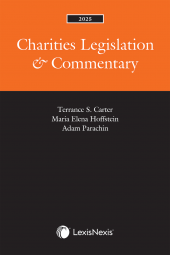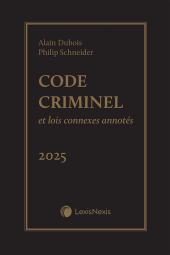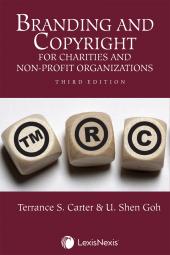Branding and Copyright for Charities and Non-Profit Organizations, 3rd Edition
One Year Subscription Only Terms
Subscribers receive the product(s) listed on the Order Form and any Updates made available during the annual subscription period. Shipping and handling fees are not included in the annual price.
Subscribers are advised of the number of Updates that were made to the particular publication the prior year. The number of Updates may vary due to developments in the law and other publishing issues, but subscribers may use this as a rough estimate of future shipments. Subscribers may call Customer Support at 800-833-9844 for additional information.
Subscribers may cancel this subscription by: calling Customer Support at 800-833-9844; emailing customer.support@lexisnexis.com; or returning the invoice marked 'CANCEL'.
If subscribers cancel within 30 days after the product is ordered or received and return the product at their expense, then they will receive a full credit of the price for the annual subscription.
If subscribers cancel between 31 and 60 days after the invoice date and return the product at their expense, then they will receive a 5/6th credit of the price for the annual subscription. No credit will be given for cancellations more than 60 days after the invoice date. To receive any credit, subscriber must return all product(s) shipped during the year at their expense within the applicable cancellation period listed above.
Détails des produits
As the authors explain in the first chapter of this new edition of Branding and Copyright for Charities and Non-Profit Organizations, Canada’s non-profit and voluntary sector is the second largest in the world, with more than 170,000 charities and non-profit organizations and revenues expected to climb to $200 billion by 2026. In such an important – but crowded – sector, the need for effective branding has become more crucial than ever, as has the need for an insightful, up-to-date text on the subject.
This third edition of Branding and Copyright for Charities and Non-Profit Organizations explores the importance of branding and copyright in this sector, and provides helpful guidance on how organizations can best use and protect their valuable assets, including under Canada’s recently amended Trademarks Act.
Comprehensive Overview
Written in plain, accessible language by leading charity law counsel, Branding and Copyright for Charities and Non-Profit Organizations offers practical insight and advice related to issues and areas of concern to non-profit organizations. In addition to examining recent changes to the law, this book discusses compliance issues in light of evolving social media practices and uses examples to illustrate the application of legal principles.
The authors cover a broad range of topics, including:
- Working with intellectual property counsel to build a positive brand
- Choosing the right form of trademark for an organization’s needs
- Expediting the registration process
- Saving money under foreign registration systems
- Conducting appropriate research before selecting a trademark
- Preventing infringement and abuse of trademarks
- Using domain names and the Internet wisely
- Avoiding pitfalls when licensing trademarks through co-branding and sponsorship arrangements
- Selecting the right type of protection under copyright law
- Using others’ copyrighted work legally through permission or copyright exceptions
- Equipping an organization to recognize and respond to copyright infringement
In addition, this updated edition discusses the amendments to trademarks law since the passing of Bill C-86 in December 2018 (in force June 17, 2019) as well as the changes in practice for trademarks registered in Canada as compared to those registered internationally.
A Go-To Resource
This third edition of Branding and Copyright for Charities and Non-Profit Organizations will be a useful acquisition for:
- Large charities and non-profit organizations that require a general reference on copyright and trademark law and how the legislation applies to charities and non-profit organizations
- Lawyers for charities and in-house counsel for non-profit organizations who need to provide advice on copyright and trademark law
- Intellectual property lawyers who are relied on to provide advice on the application of copyright and trademark law to non-profit organizations
Table des matières
Introduction
Chapter 1: Branding and its importance to charities and non-profit organizations
1. What is branding?
2. Why is branding important to charities and non-profit organizations?
3. How do trademarks become wasting assets for charities and non-profit organizations?
Chapter 2 : Trademark overview for charities and non-profit organizations
1. What is a trademark?
2. What is the difference between a trademark and other types of marks?
3. What is the difference between a trademark and other types of names?
4. What is the difference between a trademark and other types of intellectual property?
Chapter 3: Protection for unregistered trademarks
1. Validity
2. Time
3. Geographical area
4. Goods and services
5. Justification
Chapter 4 : Protection for registered trademarks
1. Validity
2. Time
3. Geographical area
4. Goods and services
5. Justification
6. Constitutionality
Chapter 5: Trademark exceptions: “Users, keepers; losers, weepers”
1. Trademark selection
2. Trademark registrability
3. Trademark use
4. Trademark searches
Chapter 6 : Trademark enforcement
1. Section 7 passing off
2. Sections 19 and 20 infringement
3. Section 22 depreciation of goodwill
4. Proactive countermeasures
5. Suing foreign infringers
Chapter 7 : Copyright overview for charities and non-profit organizations
1. What is copyright?
2. What are moral rights?
Chapter 8 : Copyright protection
1. Copyright is automatic
2. Copyright can be formalized
3. Term of copyright
4. Ownership of copyright
Chapter 9 : Copyright exceptions: “Fair is foul, and foul is fair”
1. Fair dealing
2. Private purposes
3. Educational institutions, libraries, archives and museums
4. Persons with perceptual disabilities
5. Religious, educational, charitable or fraternal organizations
Chapter 10: Copyright enforcement
1. Copyright
2. Moral rights
3. Common myths
4. Examples
Chapter 11: Protecting the brand through domain names
1. What is a domain name?
2. Importance of domain names
3. Domain name conflicts
4. Securing domain names
5. Contesting domain names
6. Licensing domain names
Chapter 12: Protecting the brand through licensing
1. What is licensing?
2. When is licensing relevant?
3. Licensing requirements
4. Licensing considerations
Conclusion
Appendix I: Trademarks Act
Appendix II: Copyright Act
Produits liés
-
Nouveau!Précommander
 Charities Legislation & Commentary, 2025 EditionNouveau!Date de sortie: December 31, 202495,00 $
Charities Legislation & Commentary, 2025 EditionNouveau!Date de sortie: December 31, 202495,00 $ -
 Le droit linguistique au Québec, 2e éditionDate de sortie: September 09, 2024155,00 $
Le droit linguistique au Québec, 2e éditionDate de sortie: September 09, 2024155,00 $ -
 Code criminel et lois connexes annotés, édition 2025 (Volume 1) + Guide du praticien (Volume 2) + Livre électroniqueDate de sortie: August 13, 2024175,00 $
Code criminel et lois connexes annotés, édition 2025 (Volume 1) + Guide du praticien (Volume 2) + Livre électroniqueDate de sortie: August 13, 2024175,00 $
 Lexis Nexis
Lexis Nexis 